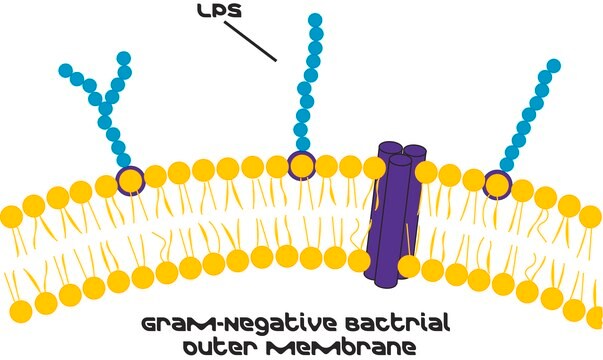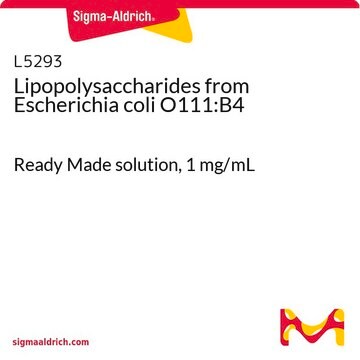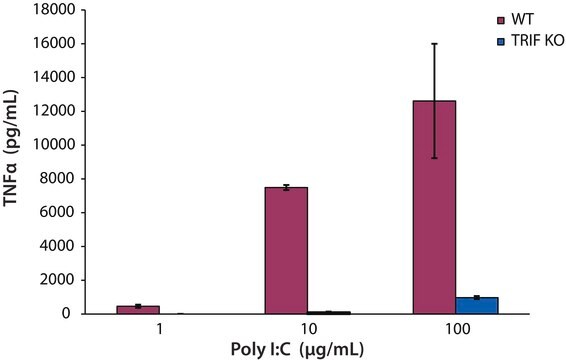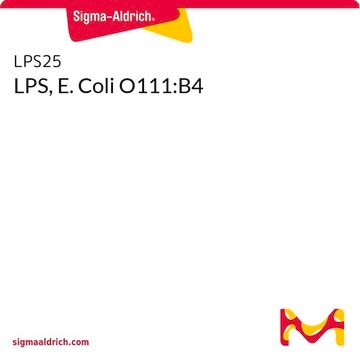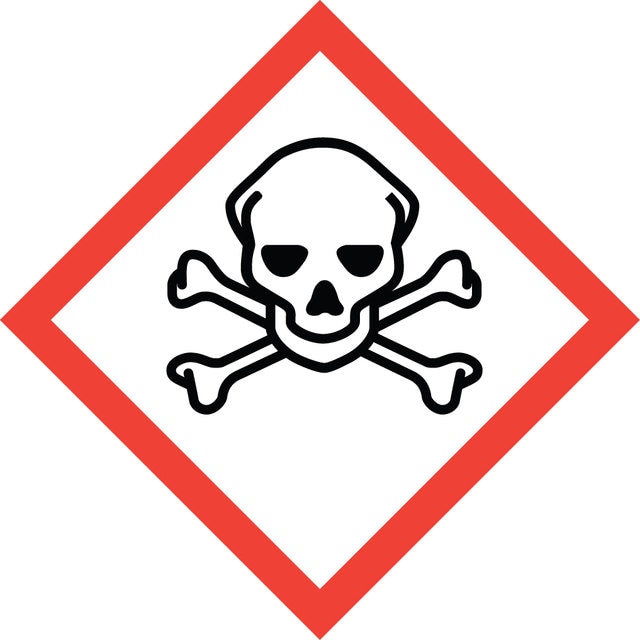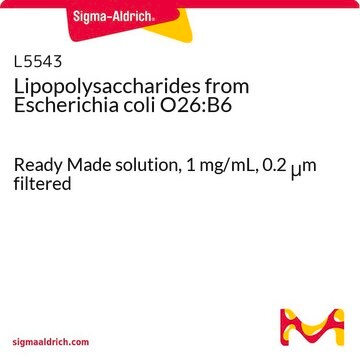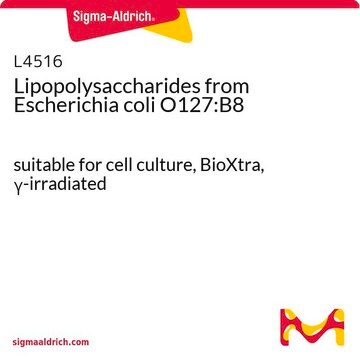추천 제품
생물학적 소스
Escherichia coli (O111:B4)
Quality Level
양식
lyophilized powder
정제법
ion-exchange chromatography
불순물
<1% Protein
<1% RNA
색상
white to yellow cast
solubility
water: soluble
배송 상태
ambient
저장 온도
2-8°C
유사한 제품을 찾으십니까? 방문 제품 비교 안내
일반 설명
This product is extracted from E. coli serotype O111:B4 and purified by ion exchange. The source strain is from a private collection. This LPS serotype has been used to stimulate B-cells and induce NOS in human hepatocytes.
애플리케이션
Lipopolysaccharides (LPSs) are characteristic components of the cell wall of Gram-negative bacteria. LPS and its lipid A moiety stimulate cells of the innate immune system by the Toll-like receptor 4 (TLR4), a member of the Toll-like receptor protein family, which recognizes common pathogen-associated molecular-patterns (PAMPs).
생화학적/생리학적 작용
Lipopolysaccharides (LPS) are localized in the outer layer of the membrane and are, in noncapsulated strains, exposed on the cell surface. They contribute to the integrity of the outer membrane, and protect the cell against the action of bile salts and lipophilic antibiotics.
제조 메모
The product is soluble in water (5 mg/mL) or cell culture medium (1 mg/mL) yielding a hazy, faint yellow solution. A more concentrated, though still hazy, solution (20 mg/mL) has been achieved in aqueous saline after vortexing and warming to 70-80 °C. Lipopolysaccharides are molecules that form micelles in every solvent. Hazy solutions are observed in water and phosphate buffered saline. Organic solvents do not give clearer solutions. Methanol yields a turbid suspension with floaters, while water yields a homogeneously hazy solution.
기타 정보
To gain a comprehensive understanding of our extensive range of Lipopolysaccharides for your research, we encourage you to visit our Carbohydrates Category page.
관련 제품
제품 번호
설명
가격
신호어
Danger
유해 및 위험 성명서
Hazard Classifications
Acute Tox. 2 Oral
Storage Class Code
6.1A - Combustible acute toxic Cat. 1 and 2 / very toxic hazardous materials
WGK
WGK 3
Flash Point (°F)
Not applicable
Flash Point (°C)
Not applicable
개인 보호 장비
Eyeshields, Gloves, type N95 (US)
이미 열람한 고객
Yoshitomo Hayama et al.
Journal of immunology (Baltimore, Md. : 1950), 200(11), 3790-3800 (2018-04-25)
Amino acid metabolism plays important roles in innate immune cells, including macrophages. Recently, we reported that a lysosomal adaptor protein, Lamtor1, which serves as the scaffold for amino acid-activated mechanistic target of rapamycin complex 1 (mTORC1), is critical for the
Carl-Fredrik Johnzon et al.
Frontiers in immunology, 9, 1487-1487 (2018-07-11)
Mastitis is an inflammatory condition of the mammary tissue and represents a major problem for the dairy industry worldwide. The present study was undertaken to study how experimentally induced acute bovine mastitis affects inflammatory parameters and changes in the metabolome.
Sharon Elazar et al.
Veterinary research, 41(1), 10-10 (2009-10-16)
Mastitis, inflammation of the mammary tissue, is a common disease in dairy animals and mammary pathogenic Escherichia coli (MPEC) is a leading cause of the disease. Lipopolysaccharide (LPS) is an important virulence factor of MPEC and inoculation of the mammary
F T Silvestre et al.
Journal of dairy science, 94(5), 2285-2301 (2011-04-29)
The objectives were to evaluate the effects of differential supplementation of Ca salts (CS) of fatty acids (FA) on plasma acute phase proteins and both FA composition and function (i.e., activity and cytokine production) of neutrophils, during the peripartum and
Simon N Willis et al.
Nature communications, 8(1), 1426-1426 (2017-11-12)
Humoral immunity requires B cells to respond to multiple stimuli, including antigen, membrane and soluble ligands, and microbial products. Ets family transcription factors regulate many aspects of haematopoiesis, although their functions in humoral immunity are difficult to decipher as a
자사의 과학자팀은 생명 과학, 재료 과학, 화학 합성, 크로마토그래피, 분석 및 기타 많은 영역을 포함한 모든 과학 분야에 경험이 있습니다..
고객지원팀으로 연락바랍니다.